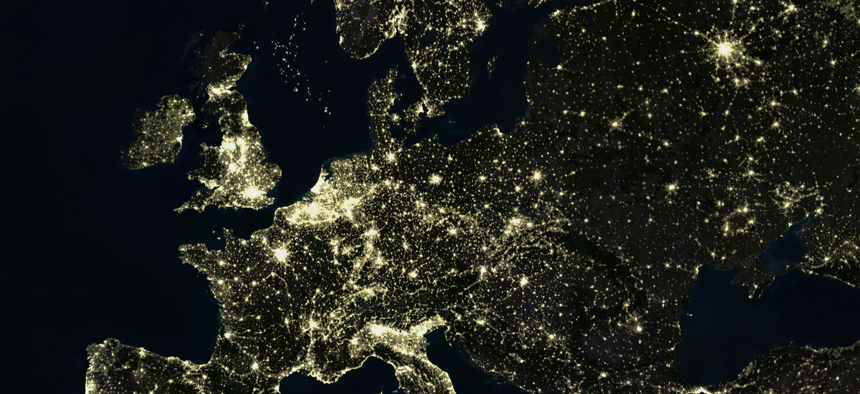
True colour satellite image of Europe at night with country borders. Planet Observer/Universal Images Group via Getty Images
Mind the ‘Middle Powers’ Gap
While pivoting from terrorism to great powers, the U.S. should pay far more attention those countries caught in the struggle between democracy and authoritarianism.
Weak states can pose as great a danger to U.S. national interests as strong ones, President George W. Bush declared after the 9/11 attacks, and so Washington embarked on two decades of counterterrorism. But the next decade is likely to highlight the importance of middle powers, each of “whose leaders consider that it cannot act alone effectively but may be able to have a systemic impact in a small group or through an international institution,” as Robert Keohane has written.
For many reasons, there has been a tendency to overlook the impact of the constellation of states that exists below the upper tier. Population size, resource wealth, diplomatic prowess, and economic influence can all be indicators of a country’s status as a middle power and factors in how to engage with them and form sustainable foreign policy strategies. But given the evolution of warfare, small states with sophisticated cyber capabilities, like Israel and Taiwan, can punch far above their weight.
Middle powers are crucial to the struggle between democracies and authoritarian countries. As competitors, the United States and China are in constant competition to build and strengthen alliances and coalitions while denying the other the ability to do so. While many states are wary of China’s growing power, economic reliance on Beijing is a reality that many also welcome, and most are forced to contend with. As such, many middle powers, like Indonesia, believe that a “Cold War” mentality that suggests states must choose between China and the U.S. is counterproductive. But already, some states have picked sides.
In the Indo-Pacific theater, the Shanghai Cooperation Organization, or SCO, led by China and Russia is growing, having just been approved to start the process for Iran’s acceptance as a full member. While the SCO has been around since 2001, it has been historically criticized for lacking teeth. But with shifting dynamics on the Eurasian continent, the SCO may prove an important vehicle for its members. Meanwhile, the United States has re-invigorated “the Quad,” an informal bloc of India, Australia, Japan, and the United States, having recently hosted the leaders of each state in Washington, D.C., for the first in-person summit. Beijing views the Quad as an anti-China alliance.
The middle powers that comprise membership in these formal and informal alliances play an important role in the global balance of power. Consider Turkey’s membership in NATO. Other members have voiced concerns over Ankara’s increasing reliance on military equipment from Russia, Turkish military offensives inside Syria, and Recep Tayyip Erdoğan’s threats against U.S. troops working with Kurdish forces. But Turkey, a country of 84 million people and boasting a large and well-trained military, is a middle power looking to play a more central role in international affairs. Relying on mercenaries and armed drones, Ankara has intervened in numerous conflicts, from Libya to Nagorno-Karabakh, in Azerbaijan. Through it all, NATO leaders protest but continue trying to keep Ankara aligned with the alliance.
Other middle powers, like Ukraine, have less room for error as major powers threaten or infringe upon their sovereignty. In its conflict with Russia, Ukraine has relied on Western support, particularly from the U.S. and its allies, but Kiev understands its limitations. There is evidence that some of the people who make up Ukraine’s volunteer battalions adhere to white supremacy extremism and neo-Nazi ideology, including foreigners who traveled from numerous Western countries. At the height of the conflict, these volunteer battalions were instrumental in battling the pro-Russian forces, but having extremists flock to the conflict and gaining valuable battle experience pose a clear security concern to the United States—where far-right extremism is on the rise.
Geography matters in geopolitics. The United States has the luxury of being geographically secluded from the geopolitical struggles and fault lines that have plagued European and Asian countries over time. But the distance that provided America an advantage in the 20th century may prove a disadvantage in the 21st. China, on the other hand, is using its Belt-and-Road Initiative to integrate itself into key geographical areas in Eurasia and beyond.
Most middle powers are more restricted in how to deploy their limited resources. In short, they need to get more bang for their buck. To that end, many middle powers are increasingly engaging in more cost-effective modes of aggression and deterrence than China’s global infrastructure and construction projects. Most worrisome—and the one that U.S. security leaders should give closer attention—is the rise in reliance on proxy forces to achieve security policy objectives, a strategy embraced by Turkey, Pakistan, and Iran, among others.
“The strong do what they can; the weak suffer what they must,” said Thucydides in his History of the Peloponnesian War. Even he neglected the world’s middle powers. U.S. leaders should start paying attention, before it’s too late.
Colin P. Clarke, Ph.D., is the director of policy and research at the Soufan Group and a senior research fellow at the Soufan Center.
Mollie Saltskog is a senior intelligence analyst at the Soufan Group and a research fellow at the Soufan Center.